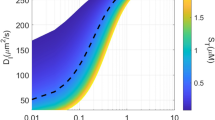Summary
Stimulations or inhibitions by various agents of45Ca efflux from prelabeled cells or tissues display distinct and reproducible profile patterns when the results are plotted against time as fractional efflux ratios (FER). FER is the fractional efflux of45Ca from stimulated cells divided by the fractional efflux from a control unstimulated group. These profile patterns fall into three categories: peak patterns, exponential patterns, and mixed patterns. Each category can be positive (stimulation) or negative (inhibition). The interpretation of these profiles is difficult because45Ca efflux depends on three variables: the rate of calcium transport out of the cell, the specific activity of the cell compartment from which the calcium originates, and the concentration of free calcium in this compartment. A computer model based on data obtained by kinetic analyses of45Ca desaturation curves and consisting of two distinct intracellular pools was designed to follow the concentration of the traced substance (40Ca), the tracer (45Ca), and the specific activity of each compartment before, during, and after the stimulation or the inhibition of calcium fluxes at various pool boundaries. The computer model can reproduce all the FER profiles obtained experimentally and bring information which may be helpful to the interpretation of this type of data. Some predictions of the model were tested experimentally, and the results support the views that a peak pattern may reflect a sustained change in calcium transport across the plasma membrane, that an exponential pattern arises from calcium mobilization from an internal subcellular pool, and that a mixed pattern may be caused by a simultaneous change in calcium fluxes at both compartment boundaries.
Similar content being viewed by others
References
Borle, A.B. 1971. Calcium transport in kidney cells and its regulation in cellular mechanisms for calcium transfer and homeostasis. G. Nichols, Jr., and R.H. Wasserman, editors, pp. 151–174. Academic Press, New York
Borle, A.B. 1975. Methods for assessing hormone effects on calcium fluxesin vitro.In: Methods in Enzymology, Vol. 39. Hormone Action, part D, Isolated Cells, Tissues and Organ Systems. J.G. Hardman and B.W. O'Malley, editor. p. 513–573. Academic Press, New York
Borle, A.B. 1981. Control, regulation and modulation of cell calcium.Rev. Physiol. Biochem. Pharmacol. 90:13–153
Borle, A.B. 1982. Effect of sodium on cellular calcium transport in rat kidney.J. Membrane Biol. 66:183–191
Borle, A.B., Briggs, F.N. 1968. Microdetermination of calcium in biological material by automatic fluorometric titration.Anal. Chem. 40:339–344
Borle, A.B., Clark, J. 1981. Effects of phosphate induced hyperparathyroidism and parathyroidectomy on rat kidney calciumin vivo.Am. J. Physiol. 241:E136-E141
Borle, A.B., Uchikawa, T. 1978. Effects of parathyroid hormone on the distribution and transport of calcium in cultured kidney cells.Endocrinology 102:1725–1732
Borle, A.B., Uchikawa, T. 1979. Effects of adenosine 3′,5′-monophosphate, dibutyryl adenosine 3′,5′-monophosphate, aminophylline and imidazole on renal cellular calcium metabolism.Endocrinology 104:122–129
Garfinkel, D., Ching, S.W., Adelman, M., Clark, P. 1966. Techniques and problems in the construction of computer models of biochemical systems including real enzymes.Ann. N.Y. Acad. Sci. 128:1054–1068
Kikuchi, M., Wollheim, C.B., Cuendet, G.S., Renold, A.E., Sharp, G.W.G. 1978. Studies on the dual effect of glucose on45Ca efflux from isolated rat islets.Endocrinology 102:1339–1349
Lowry, O.H., Rosebrough, N., Farr, A., Randall, R. 1951. Protein measurement with the Folin phenol reagent.J. Biol. Chem. 193:265–275
Malaisse, W.J., Brisson, G.R., Baird, L.E. 1973. Stimulus-secretion coupling of glucose-induced insulin release: X. Effect of glucose on45Ca efflux from perfused islets.Am. J. Physiol. 224:389–394
Merchant, D.J., Kahn, R.H., Murphy, W.H. 1964. Handbook of Cell and Organ Culture. Burgess, Minneapolis
Studer, R.K., Borle, A.B. 1979. Effect of pH on the calcium metabolism of isolated rat kidney cells.J. Membrane Biol. 48:325–341
Studer, R.K., Borle, A.B. 1980. The effects of hydrogen ions on the kinetics of calcium transport by rat kidney mitochondria.Arch. Biochem. Biophys. 203:707–718
Uchikawa, T., Borle, A.B. 1978. Kinetic analysis of calcium desaturation curves from isolated kidney cells.Am. J. Physiol. 234:R29-R33
Uchikawa, T., Borle, A.B. 1978. Studies of calcium-45 desaturation from kidney slices in flow-through chambers.Am. J. Physiol. 234:R34-R38
Author information
Authors and Affiliations
Rights and permissions
About this article
Cite this article
Borle, A.B., Uchikawa, T. & Anderson, J.H. Computer simulation and interpretation of45Ca efflux profile patterns. J. Membrain Biol. 68, 37–46 (1982). https://doi.org/10.1007/BF01872252
Received:
Revised:
Issue Date:
DOI: https://doi.org/10.1007/BF01872252




